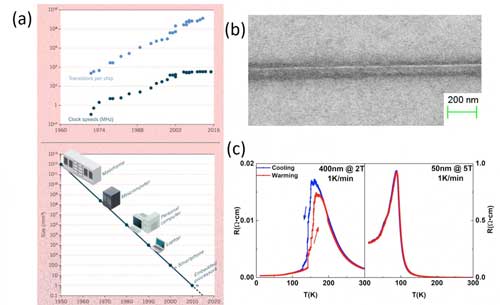| Nov 22, 2019 | |
Scientists reveal the dominant role of quenched disorder on complex oxide nanowires(Nanowerk News) The semiconductor industry has been developed for more than 40 years following the Moore's Law. With the size of transistors being shrinking down to tenth of nanometer scale, the quantum effects start to dominate and cause problems such as operation stability and heat generations [Fig. 1a]. |
|
| An alternative route is to develop new functional materials and their architectures. Complex oxide is one of the most promising candidates. Recently, scientists have shown novel phenomena of complex oxide at nanometer length scale and its potential for applications. | |
| In the article "Spatial confinement tuning of quenched disorder effects and enhanced magnetoresistance in manganite nanowires" published in Science China Physics, Mechanics & Astronomy ("Spatial confinement tuning of quenched disorder effects and enhanced magnetoresistance in manganite nanowires"), scientists has fabricated a series of complex oxide known as manganites nanowires ranging from 5 µm to 50 nm, by using state-of-the-art nanolithography techniques [Fig. 1b]. | |
| From transport and magnetic imaging measurements, scientist reveals that when the nanowire size is smaller, the effect of quenched disorder becomes significantly enhanced – a new phenomenon that has not been identified before at nanometer scale [Fig. 1c]. | |
 |
|
| (a) Moore's law: the number of transistors per microprocessor chip has roughly doubled every two years [1]. (b) a 100 nm manganite nanowire fabricated. (c) The transport properties of the nanowires showing significantly enhanced quenched disorder effects in 50 nm nanowire. (©Science China Press) (click on image to enlarge) | |
| Quenched disorder: In condensed matter physics, quenched disorder usually refers to the randomness in a material which is "frozen" or "quenched" at all times. The most common source of quenched disorder comes from impurities or chemical dopants. Quenched disorder plays significant roles in complex oxide systems. | |
| Extensive theoretical treatments have shown the critical role of quenched disorder in complex oxide systems such as high-Tc cuprates and colossal magnetoresistive manganites. Experimental investigations, on the other hand, are rather complicated. The most common way to control quenched disorder is by chemical doping. However, chemical doping simultaneously alters material's chemical environments, structures, etc., clouding the impact of quenched disorder. | |
| In this article, the scientist shows that spatial confinement is a clean and effective way to study quenched disorder effect without changing the chemical environments, structure and other physical parameters. | |
| The results reveal that enhanced quenched disorder not only can alter the nature of electronic and magnetic phase transition, but increase the magnetoreisistance up to 820000 %, a 200 times enhancement to its original values. These phenomena offer new routes on the understanding of complex materials at nanometer scales and their potential applications. |
| Source: Science China Press | |
|
Subscribe to a free copy of one of our daily Nanowerk Newsletter Email Digests with a compilation of all of the day's news. |
